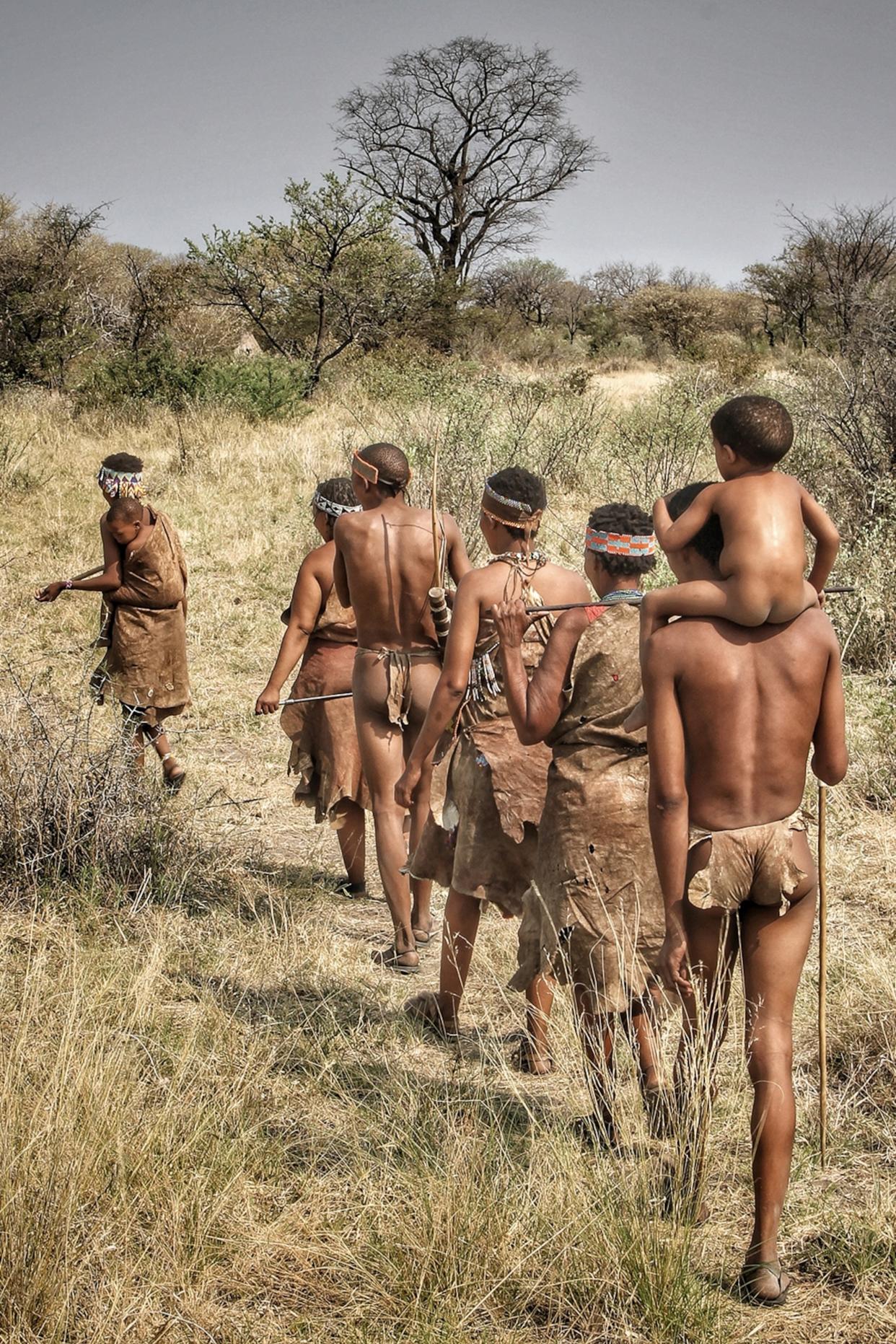
This article was produced by National Geographic Traveller (UK).
On an African safari, it’s good to adjust your viewpoint from time to time. As your impressions shift, the experience deepens. Wildlife-watching from the deck of a lodge or the back of a safari vehicle can be exciting and inspiring, but that’s nothing compared to the thrill of taking the front seat or, even better, exploring a nature reserve on foot. At ground level, sounds and smells seem amplified: the crunch of sand or twigs underfoot, the tang of hot dust, the sweet whiff of wild herbs in the air.
Ready to summon a rush of raw emotions? Try doing what I’m doing: hunkering down in the tawny grass for a lion’s-eye view of things. It’s highly unlikely that we’ll be surprised by a big cat here in northeast Namibia’s Nyae Nyae Conservancy — counting both guides and guests, there are well over a dozen people on my morning bushwalk, and there’s safety in numbers. But there are definitely predators in this stretch of the Kalahari Desert, somewhere, and there’s every chance that we’ll spot their tracks.

We’ve sunk down on our haunches for an impromptu lesson in fire-starting. Our guides are a party of Ju/’Hoansi-San (the /’ denotes one of the 48 different click sounds in their dialect). Dressed for the occasion in traditional antelope skins and beads, they’re showing me some of the old ways.
Prompted by a dignified elder, /Kaece, and his wife, //‡Oro, the lesson unfolds. It starts, swiftly and simply, with friction. “Speed and steadiness is important, and strong hands,” says /Kaece via Tsamkgao !I/ae, my Ju/’Hoan interpreter.
Using rapid palm movements to rotate a vertical stick in a notch in a second stick that’s laid horizontally, /Kaece generates enough heat to create curls of smoke in a bird’s nest-like bundle of dry grass beneath. Cupping the grass, he blows softly, jerking his head away with a grin when the first flames leap out. “If you think that looks easy, give it a try,” says Tsamkgao. I quickly discover it’s not easy at all.
With hands smarting from the effort, I rise to my feet, feeling slightly giddy. A shimmer of heat haze blurs the horizon. We press on, /Kaece and his extended family leading me along sandy paths trodden by many generations of antelopes. Pausing every so often at a low tree or shrub, they show me which leaves can be chewed or crushed and used as a stomach medicine, antiseptic or stimulant. Next, they demonstrate which tubers, when hacked open, deliver precious drops of water — a crucial resource in this endless-seeming swathe of arid scrubland, devoid of rivers or waterholes. In the Ju/’Hoansi’s gentle company, this sun-baked landscape seems bountiful and positively hospitable, but I’m fully aware that if they left me here alone, I wouldn’t stand a chance.
Southern Africa’s San, who sometimes call themselves Bushmen, have always considered themselves the oldest people on Earth. Genetic research suggests that for most of the past 150,000 years, they were the world’s largest ethnic group. In recent centuries, however, they have dwindled to around a hundred thousand, with the Ju/’Hoansi a minority within this population: it’s thought that just a few thousand Ju/’Hoan speakers remain.

In the early 20th century, the Ju/’Hoansi were still living a nomadic life, hunting and gathering in the wildlife-rich region that later became Etosha National Park. Etosha was recognised as an official reserve in 1907, and within 50 years, the pre-independence apartheid government had driven the nomads out of their traditional hunting grounds or n!ore, the Ju/’hoansi word for ‘the place to which you belong’. Banned from Etosha, they were pushed east into an isolated, arid and hostile block of the Kalahari that the government called Bushmanland, adjoining the border with Botswana. Most settled in or around the ragged village of Tjum!kui (or Tsumkwe), around 300 miles from Etosha. Forced to abandon their hunter-gatherer lifestyle, the Ju/’Hoansi struggled to adjust. Their culture of equality and tolerance was not suited to a system in which the best way to get their voices heard was to appoint leaders and committees, and they have been marginalised ever since.
Ecotourism projects like my bushwalk offer glimmers of hope, however. Run by the Ju/’Hoansi on their own terms, they generate funds for the communities, while protecting nature and keeping ancestral skills alive. The Ju/’Hoansi’s understanding of native botany has created other opportunities, too: a root called devil’s claw, for example, is in international demand as an anti-inflammatory treatment for rheumatism and arthritis.
“Whether it’s for tourists or for medicine, it’s our knowledge of plants in the bush that pays for modern essentials like transport and schooling,” says Tsamkgao. “If things were different and we didn’t need money, we could survive by foraging and hunting for just a couple of hours a day, leaving more time for socialising or making art. It’s hard to imagine a healthier lifestyle.”
Published in the Middle East & Africa Collection 2023/24, distributed with the August 2024 issue of National Geographic Traveller (UK).
EMEA Tribune is not involved in this news article, it is taken from our partners and or from the News Agencies. Copyright and Credit go to the News Agencies, email news@emeatribune.com Follow our WhatsApp verified Channel





